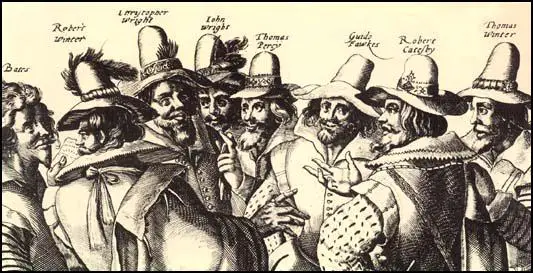Thomas Percy
Thomas Percy was born in about 1558. He studied at Cambridge University and graduated in 1580. As a young man he gained a reputation as a swordsman and fought many duels.
In 1591 Percy married Martha Wright, the sister of Christopher Wright and John Wright. Four years later, a relative, the Earl of Northumberland, appointed him as his agent. This involved him managing the Earl's estates. Later he was employed as Constable of Alnwick Castle.
Northumberland was a Roman Catholic and in 1602 sent Percy to Scotland with letters to James where he argued that Catholics would accept him as king if he brought an end to the persecution of religious dissents. Later Percy told his friends that James had promised to treat Catholics as equals with Protestants.
When Elizabeth I died in 1603 without children, James became king. Roman Catholics became very angry when James passed a law that imposed heavy fines on people who did not attend Protestant church services.
In 1605 Catesby devised the Gunpowder Plot, a scheme to kill James and as many Members of Parliament as possible. Catesby planned to make the king's young daughter, Elizabeth, queen. In time, Catesby hoped to arrange Elizabeth's marriage to a Catholic nobleman. Over the next few months Catesby recruited Thomas Percy to join the conspiracy.
Catesby's plan involved blowing up the Houses of Parliament on 5 November. This date was chosen because the king was due to open Parliament on that day. At first the group tried to tunnel under Parliament. This plan changed when a member of the group was able to hire a cellar under the House of Lords. The plotters then filled the cellar with barrels of gunpowder. Guy Fawkes was given the task of creating the explosion.

One of the people involved in the plot was Francis Tresham. He was worried that the explosion would kill his friend and brother-in-law, Lord Monteagle. Tresham therefore sent Lord Monteagle a letter warning him not to attend Parliament on 5 November.
Lord Monteagle became suspicious and passed the letter to Robert Cecil, the king's chief minister. Cecil quickly organised a thorough search of the Houses of Parliament. While searching the cellars below the House of Lords they found the gunpowder and Guy Fawkes. He was tortured and he eventually gave the names of his fellow conspirators.
The conspirators left London and agreed to meet at Holbeche House in Staffordshire. News of their hiding place reached the Sheriff of Worcester and on 8th November the house was surrounded by troops. The men refused to surrender and gunfire broke out. Over the next few minutes Thomas Percy, Robert Catesby, Christopher Wright and John Wright were killed.
